Talybont (Tal-y-Bont) is a village which lies mid-way between Aberystwyth and Machynlleth, on the A487 main road. The village mainly came about due to the number of silver and lead mines in the vicinity. The men of the village who fell during both World Wars are commemorated on a tablet inside the village Memorial Hall, which was opened on 6 August 1924.
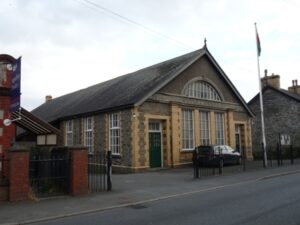
The Great War, 1914-1918
Gwilym Lloyd Davies, Gunner, 237483, Royal Field Artillery. Gwilym was the son of Thomas and Hannah Maria Davies, of 1, Birkenhead Street, Talybont. He enlisted at Stratford, London into the Royal Artillery, and was posted to France with the 41st Brigade, Royal Field Artillery (16th E Battery), which was attached to the 2nd Division. Gwilym was killed in action near Arras on 18 October 1918. He was 24 years old, and is buried in St. Vaast Communal Cemetery Extension, France.
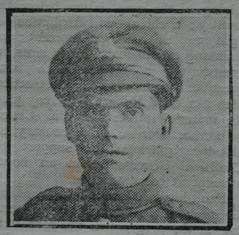
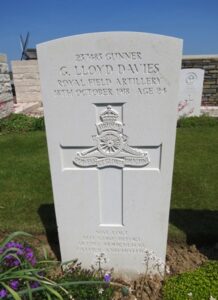
William Henry Edwards, Private, 13224, Devonshire Regiment. William was born at Tonyrefail in 1881, the son of Morgan and Elizabeth Edwards. The family later resided at Lerry View, Elerch, Talybont. William enlisted at Tonyrefail into the 2nd Battalion, Devonshire Regiment, which was attached to 23 Brigade, 8th Division. The Division moved to the Western Front in November 1914, a badly-needed reinforcement to the BEF which had been all but wiped out at Ypres. They saw their first major action at the Battle of Neuve Chapelle, and then at the Battle of Aubers. William was wounded at Aubers Ridge, and died on 10 May 1915, aged 34. He is buried in Sailly-Sur-La-Lys Canadian Cemetery, France. William does not appear to be commemorated anywhere locally.
Jenkin Evan Evans, Private, 767319, London Regiment. Jenkin was born at Southwark on 20 August 1899, the son of Jenkin Evan and Catherine Jane Evans, of The Woodlands, Talybont. He enlisted at Carmarthen on 22 November 1917 into the 28th Battalion, London Regiment (Artists Rifles), which was in France attached to 190 Brigade, 63rd (Royal Naval) Division. He landed in France on 8 April 1918, joining the battalion on the Somme, after its ordeals during the German offensive over the previous fortnight. Jenkin was wounded during the launch of the Battle of Albert, and died of his wounds on 23 August 1918, aged 19. He is buried at Foncquevillers Military Cemetery, France.
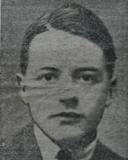
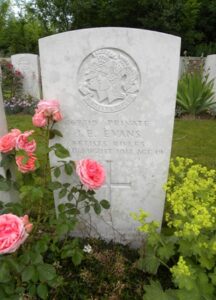
Howard Hughes, Private, 28943, South Wales Borderers. Howard was the son of Daniel and Margaret Hughes, of Talybont, and the husband of Hannah Hughes, of 2, Elgar Terrace, Talybont. He enlisted at Aberystwyth into the army, and was posted to France in 1916 to join the 1st Battalion, South Wales Borderers, which was attached to 3 Brigade, 1st Division. In the summer of 1916 the Division was on the Somme, and took part in the Battle of Delville Wood and the Battle of the Ancre, and the ensuing Operations on the Ancre. In March 1917 the Division followed the German Retreat to the Hindenburg Line, and in April they fought at Arras, during the First Battle of the Scarpe, the Battle of Arleux and the Third Battle of the Scarpe. Their next major action was at the Battle of Cambrai, and it was there that Howard was wounded. He died of his wounds in hospital at Wimereux on 25 November 1917, aged 31. Howard is buried at Wimereux Communal Cemetery, France.
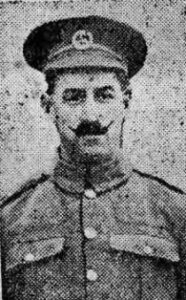
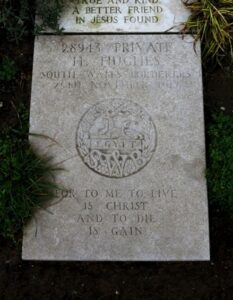
Richard Rowland Humphreys, Private, 35141, Welsh Regiment. Richard was the son of Mrs. Jane Humphreys, of 4, Birkenhead Street, Talybont. He enlisted at Bridgend into the army, and was posted to the 15th Battalion, Welsh Regiment, which was known as the Carmarthen Pals battalion, attached to 114 Brigade, 38th (Welsh) Division. On 2 December 1915 the battalion moved to France, and the entire Division moved to the Fleurbaix sector, where it was initiated into trench warfare. During June 1916 the Division marched south to the Somme, and on 7 July 1916 attacked Mametz Wood. The initial attack failed, and it was three days later, on 10 July, that a fresh attack was mounted. Richard was killed in Mametz Wood on 11 July 1916, aged 20. He is commemorated on the Thiepval Memorial, France.

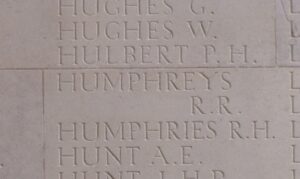
David Jones, First Engineer, Mercantile Marine. David was the son of Richard David and Mary Jones (nee Humphreys), of Ael-Y-Bryn, Talybont. He served with the Mercantile Marine aboard the SS Argyll, a Newport registered steamship. On 13 April 1917, Argyll was on route from Port Kelah for Middlesborough with a cargo of iron ore, when she was torpedoed and sunk by the German submarine U-84, with the loss of 22 lives. David was 28 years old when he died that day, and is commemorated on the Tower Hill Memorial, London.
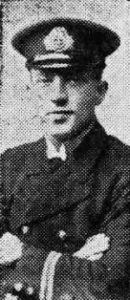
John James Jones, Sapper, 216769, Royal Engineers. John was the son of John and Susannah Jones, of Talybont. He married in 1902, and resided with his wife, Annie Jones, at 15, Gwynaw Street, Beddgelert. John enlisted at Bangor on 1 December 1916 into the Royal Engineers, and worked as a bricklayer for the Royal Engineers in Britain until being posted to France on 13 May 1918, joining the 205th Field Company, Royal Engineers, which was attached to the 35th Division. The division had just moved to Ypres, after seeing heavy fighting on the Somme, and remained at Ypres until taking part in the great offensive in August 1918. John was killed at Ypres on 20 October 1918, aged 38, and is buried in Harlebeke New British Cemetery, Belgium.
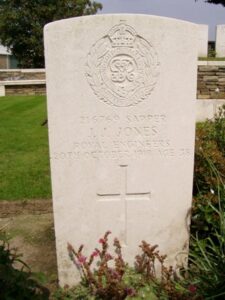
Thomas Jones, Private, 20784, Welsh Regiment. Thomas was the son of Thomas and Mary Jones, of Maldwyn House, Talybont. He enlisted at Aberystwyth on 5 March 1915 into the 15th Battalion, Welsh Regiment, which was known as the Carmarthen Pals battalion, attached to 114 Brigade, 38th (Welsh) Division. On 2 December 1915 the battalion moved to France, and the entire Division moved to the Fleurbaix sector, where it was initiated into trench warfare. During June 1916 the Division marched south to the Somme, and on 7 July 1916 attacked Mametz Wood. The initial attack failed, and it was three days later, on 10 July, that a fresh attack was mounted.. Thomas was killed during heavy hand to hand fighting within Mametz Wood on 11 July 1916. He was 24 years old, and is commemorated on the Thiepval Memorial, France.
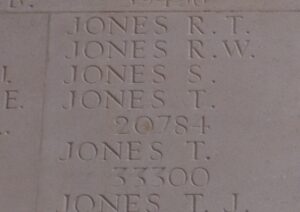
Thomas Morris Jones, Private, 27433, South Wales Borderers. Thomas was born at Llanbrynmair in 1892, the son of Jonathan and Catherine Anne Jones. He enlisted at Aberystwyth into the army, and was posted to Egypt, to join the 4th Battalion, South Wales Borderers, which was attached to 40 Brigade, 13th (Western) Division. On 12 February 1916 the Division began to move to Mesopotamia, to strengthen the force being assembled for the relief of the besieged garrison at Kut al Amara. By 27 March, the Division had assembled near Sheikh Saad and came under orders of the Tigris Corps, and then took part in the attempts to relieve Kut. However, after these efforts failed and Kut fell, the British force in the theatre was built up and reorganised. The Division then fought at the Battle of Kut al Amara, at the capture of the Hai Salient and the capture of Dahra Bend, before moving on Baghdad. Thomas was killed in action during subsequent clearing up operations, on 29 March 1917. He was 24 years old, and is commemorated on the Basra Memorial, Iraq.
Thomas Lloyd, Guardsman, 1623, Welsh Guards. Thomas was born at Ystrad Rhondda in 1896, the son of Isaac and Margaret Lloyd. His parents were from Llangynfelyn, and prior to 1911 had returned home, living at Cefn Villa, Talybont. Thomas enlisted at Aberystwyth into the 1st Battalion, Welsh Guards, joining the battalion in France on 1 November 1915 at Loos, where it was attached to the 3rd Guards Brigade, Guards Division. In July 1916 the Division moved to the Somme, where they fought at the Battle of Flers-Courcelette, and then at the Battle of Morval, capturing Lesboeufs Village. They remained here for the winter, and in March 1917 took part in the advance caused by the German Retreat to the Hindenburg Line. Later that year they moved north to Ypres, where they fought at the Battle of Pilkem, and then at the Battle of the Menin Road, Battle of Poelcapelle and the First Battle of Passchendaele. November saw them move south again, where they took part in the Battle of Cambrai. They remained in the area over the final winter of the war, and were still in positions around Gouzeaucourt when Thomas was wounded. He died of his wounds on 11 March 1918, aged 22, and is buried at Duisans British Cemetery, Etrun, France.
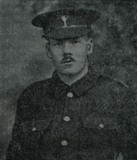
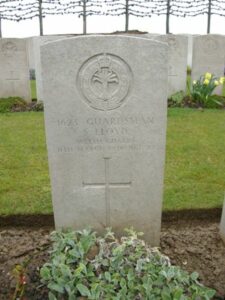
Arthur Morris, Private, 18043, Royal Welsh Fusiliers. Arthur was born at Bont-Goch on 15 December 1892, the son of William and Elizabeth Morris. Their mother, Elizabeth, had previously been married and lost her first husband John Jones, who was a lead miner at Talybont, before marrying William, who was also a lead miner. Arthur and two of his brothers had also worked as lead miners before moving to Abertridwr prior to 1911 and worked at Senghenydd Colliery. On 14 October 1913 the colliery was rocked by a massive explosion and that, coupled with the release of poison gas, resulted in the death of 439 miners. Arthur’s two brothers, William Edwin and Thomas James Morris, were among the dead. Arthur continued to work as a miner, and at the outbreak of war enlisted at Abertridwr into the Royal Welsh Fusiliers. Arthur was posted to France on 2 December 1915 with the 14th Battalion, Royal Welsh Fusiliers, which was attached to 113 Brigade, 38th (Welsh) Division, and would have taken part in its famous assault on Mametz Wood in July 1916. He was wounded at some time afterwards, and returned home, spending some time in Ireland before returning to his old battalion in France, in time to take part in the divisions advance to victory in August 1918. Arthur was killed in action on 26 August 1918 during heavy fighting at Bazentin-le-Grand, during the division’s assault on Longueval. He was 26 years old, and is buried in Caterpillar Valley Cemetery, Longueval, France. His parents later resided at Elerch House, Bont-Goch. Arthur is not commemorated locally, but at Nazareth Community Centre, Abertridwr.
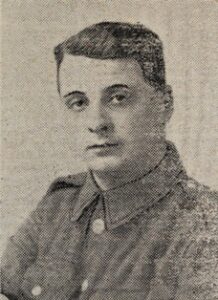
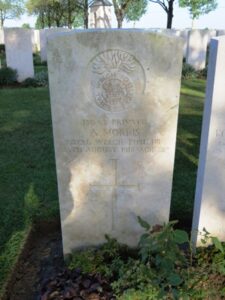
Thomas Thomas, Lieutenant, Machine Gun Corps. Thomas was the son of David Robert and Madge Thomas, of Tanyrallt, Talybont. He enlisted into the Ox and Bucks Light Infantry, and landed with them in France in August 1916. Thomas was then commissioned into the Machine Gun Corps, and was posted to the 51st Company, Machine Gun Corps, which was attached to the 17th (Northern) Division. Thomas joined his new unit on the Somme, and was killed in action there on 3 November 1916, aged 19. Thomas is buried at Guard’s Cemetery, Lesbouefs, France.
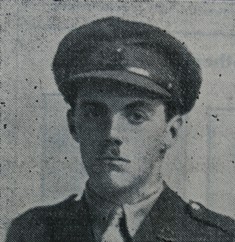
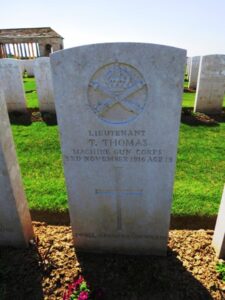
Absolom Williams, Sergeant, 5062, Royal Welsh Fusiliers. Absolom was born at Talybont in 1873. He married in 1898, and moved to Llanwonno with his wife, Elizabeth Williams, finding work as a miner. Absolom served in the Territorial Army with the 4th Battalion, Royal Welsh Fusiliers, and landed with the battalion in France on 6 November 1914. Absolom would have fought at the First Battle of Ypres, before the BEF settled into its first winter on the Western Front. He was invalided to hospital at Boulogne suffering from frostbite. Absolom was discharged from the army as medically unfit on 4 May 1916, and returned to work in the mines, at Hafod Colliery. Absolom had only been back at Hafod for two weeks when he was killed by a falling brick on 10 June 1916. No more is presently known of him, as he is not commemorated by the CWGC.
World War Two, 1939-1945
Idris Davies. Idris cannot presently be identified, but the memorial states that he resided at Glan-Aber.
Dorothy Ann Evans, Leading Aircraftwoman, 2078021, Women’s Auxiliary Air Force. Dorothy was the Daughter of David and Mary Ann Evans, of Talybont. She served with the Women’s Auxiliary Air Force. Dorothy died whilst on active service at Swansea on 10 April 1944. She was 25 years old, and is buried at Elerch (St. Peter) Churchyard.
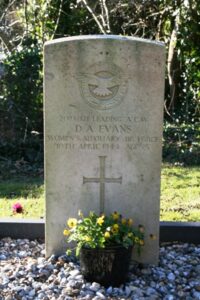
Henry Morris James, Fusilier, 14531265, Royal Welch Fusiliers. Henry was the son of William and Elizabeth James of Talybont, and the husband of Jennie Edith James, of Bow Street. He served with the 1st Battalion, Royal Welch Fusiliers. The battalion served in the Far East, in India, and then in the campaign in Burma. Henry was killed in Burma on 6 May 1944. He was 37 years old, and is commemorated on the Rangoon Memorial, Myanmar. The photograph has been kindly supplied by Tony Beck.
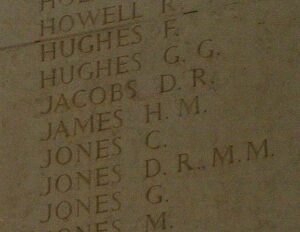
Sydney Jenkins, Gunner, 5189673, Royal Artillery. Sydney was the son of John and Ann Jenkins, of Talybont. He served with 6 Battery, 3 Anti Aircraft Maritime Regiment, Royal Artillery. Sydney was possibly wounded on active service aboard a ship, and died at Willesden, Middlesex on 2 December 1941, aged 32. He is buried at Elerch (St. Peter) Churchyard, Ceredigion. Sydney does not seem to be commemorated locally.
Alun Jones, Private, 5961701, Bedfordshire and Hertfordshire Regiment. Alun was the son of John Morgan Jones and Margaret Jones, of Talybont. He served with the 2nd Battalion, Bedfordshire and Hertfordshire Regiment. The Battalion served with the British Expeditionary Force in France, and was evacuated from Dunkirk in 1940, later sailing for the Mediterranean, and taking part in the Western Desert Campaign, and the Tunisia Campaign. The battalion then took part in the invasion of Italy. Alun was killed at Monte Cassino on 16 May 1944. He was 21 years old, and is buried at Cassino War Cemetery, Italy.
Gladys Jane Lewis, Civilian. Gwladys was the daughter of John and Ellen Lumley, of Gwynllys, Talybont. She married Evan Lewis in 1922, and the couple moved to 63, Park Road North, Acton, London, where they ran their own dairy business. Gladys was killed when three bombs were dropped on Acton by a German aircraft on 19 May 1943. She was 44 years old. Gladys does not seem to be commemorated locally.
David Williams, Flight Sergeant, 931403, Royal Air Force Volunteer Reserve. David was the son of James and Lydia Williams, of Plas-y-mynydd, Talybont. He served as a Wireless Operator/ Air Gunner with 102 Squadron, Royal Air Force. The squadron was a night bomber squadron, equipped with the Handley Page Halifax. David was killed when his Halifax was shot down over Germany on 20 December 1943. He was 29 years old, and is buried at Rheinberg War Cemetery, Germany.
John Rodd Williams, Sergeant, 1836168, Royal Air Force Volunteer Reserve. John was the son of Arthur and Agnes Williams, of Islwyn, Talybont. He served as a Flight Engineer with 158 Squadron, Royal Air Force, which was a heavy bomber squadron, equipped with the Handley Page Halifax. John was killed when his Halifax was lost during a raid over Germany on 24 March 1945. He was 20 years old, and is buried at Reichswald Forest War Cemetery, Germany.